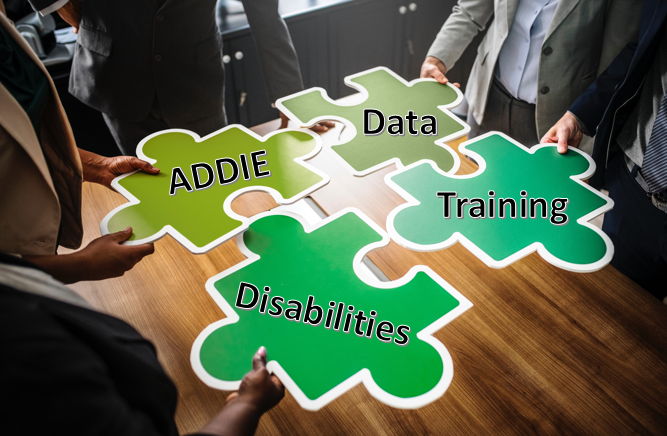Disabilities, Training, and Data: Putting it All Together
4 December 2018

Why Put It All Together?
Last summer when Incredibles 2 was released, an observant mom noticed a possible epilepsy issue due to the ‘strobe effect’ from the villain’s weapon. This led to warnings being placed in theaters and on social media. The ‘strobe effect’ is the same issue that leads to warning being placed on popular video games. Most people do not stop and think about this. Epilepsy, which falls under the Americans with Disabilities Act, is not a disease that can be seen everyday is most cases.
Unfortunately, most often (not all) training designers and developers do not consider or understand the implications of possible disabilities and their effects. This leads to training becoming ineffective or underutilized.
Recognizing Disabilities in Everyone
No matter who you develop training for, you need to understand that there is a need to develop for people with disabilities. These may be the previous example of epilepsy, or severe migraines, hearing loss, severe vision loss, loss of limb, etc.
The 2015 U.S. Census identified 12.6% of the civilian population as having a disability. Questions were asked to determine disability severity. These questions were within six categories: hearing, vision, cognition, walking or climbing stairs, difficulty with self-care, and independent living.
Beyond the civilian population, you consider the active military and veteran disabled, which is growing at 19.3 million. These groups are often overlooked due enlistment requirements. A Soldier may still be active and have a medical condition which should be considered in training development (i.e. migraines). At the same time, we owe our veterans the best training possible to assist with PTSD and any new skills for transitioning to civilian workforce.
The following TedTalk video from Keith Nolan is about 15 minutes in length. He is deaf and speaks about his fight to join the military. More importantly, he mentions the contributions other disabled Soldiers have made in the past and present in the U.S. and other armed forces throughout the world.
Developing the Training
As the training is the design stage, every consideration must be made for all learners. We often say this – but do we always mean it? Below are a couple of guidelines. Full guidelines may be found on the Section 508 site.
- Vision Impaired Learner: Every image, text, video, etc. must have alternative text built in for online training. This allows their programs to read the text and image descriptions to them. It is also a good idea to provide a transcript of the training and any videos.
- Hearing Impaired Learner: Every screen must have Closed Captioning text to allow the learner to know what is being stated. However, the Closed Captioning must have the option of being turned on or off for other learners.
These are the fairly simple guidelines. The more complicated items include the ‘strobe light’ effect. There is a guide for how many flashes per second a button or image can occur to avoid this. The site offers tips for designing and developing all instructional materials, not only online training. It is a great resource.
Data Is the Key
What does this mean for all designers and developers? As the training is developed, tested, released, and evaluated, you have the opportunity and ability to gather vast amounts of data on your training products. As designers and developers, we have an obligation to use that data to design and develop better products for all our learners. We need to take time to analyze, review, and question to determine if the Closed Captioning and alternative text is enough. Does an alternative method of a game provide an equitable approach to the learning for a disabled learner? Are they truly able to assimilate the knowledge as well? If not, what needs to be adjusted?
